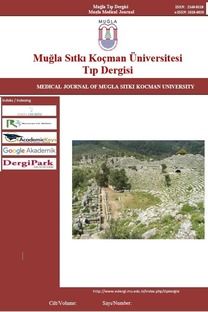Hipertiroidili Hastalarda Ampirik Sabit Doz Radyoaktif İyot Uygulamasının Tedavi Başarısı Üzerine Etkisi ve Literatürdeki Hassas Dozimetrik Yöntemlerle Kıyaslanması
Tiroid sintigrafisi, Radyoaktif iyot tedavisi, Hipertiroidizm, Hyperthyroidism, Radioactive Iodine Therapy, Thyroid Scintigraphy
The Effect of Empirical Fixed-Dose Radioactive Iodine Administration on Treatment Success in Patients with Hyperthyroidism and its Comparison with Sensitive Dosimetric Methods in the Literature
___
- 1. Bartalena L. Diagnosis and management of Graves disease: a global overview. Nat Rev Endocrinol. 2013;9(12):724.
- 2. Vanderpump MP. The epidemiology of thyroid disease. Br Med Bull. 2011;99(1):39-51.
- 3. Vija Racaru L, Fontan C, Bauriaud-Mallet M, et al. Clinical outcomes 1 year after empiric 131I therapy for hyperthyroid disorders: real life experience and predictive factors of functional response. Nucl med commun. 2017;38(9):756-63.
- 4. Holm L-E, Hall P, Wiklund K, et al. Cancer risk after iodine-131 therapy for hyperthyroidism. JNCI: J Natl Cancer Inst. 1991;83(15):1072-7.
- 5. Metso S, Auvinen A, Huhtala H, et al. Increased cancer incidence after radioiodine treatment for hyperthyroidism. Cancer. 2007;109(10):1972-9.
- 6. Ron E, Doody MM, Becker DV, et al. Cancer mortality following treatment for adult hyperthyroidism. Jama. 1998;280(4):347-55.
- 7. Ross DS, Burch HB, Cooper DS, et al. 2016 American Thyroid Association guidelines for diagnosis and management of hyperthyroidism and other causes of thyrotoxicosis. Thyroid. 2016;26(10):1343-421.
- 8. Skugor M, Wilder JB. Thyroid Disorders: A Cleveland Clinic Guide: Cleveland Clinic Press; 2006.
- 9. Nordyke RA, Gilbert FI. Optimal iodine-131 dose for eliminating hyperthyroidism in Graves’ disease. J Nucl Med. 1991;32(3):411-6.
- 10. Allahabadia A, Daykin J, Sheppard MC, et al. Radioiodine treatment of hyperthyroidism prognostic factors for outcome. J Clin Endocrinol Metab 2001;86(8):3611-7.
- 11. Jarløv AE, Hegedüst L, Kristensen LØ, et al. Is calculation of the dose in radioiodine therapy of hyperthyroidism worth while? Clin Endocrinol. 1995;43(3):325-9.
- 12. Leslie WD, Ward L, Salamon EA, et al. A randomized comparison of radioiodine doses in Graves’ hyperthyroidism. J Clin Endocrinol Metab2003;88(3):978-83.
- 13. Catargi B, Leprat F, Guyot M, et al. Optimized radioiodine therapy of Graves’ disease: analysis of the delivered dose and of other possible factors affecting outcome. Eur J Endocrinol.1999;141(2):117-21.
- 14. Alexander EK, Larsen PR. High dose 131I therapy for the treatment of hyperthyroidism caused by Graves’ disease. J Clin Endocrinol Metab. 2002;87(3):1073-7.
- 15. Erdogan MF, Küçük NÖ, Anl C, et al. effect of radioiodine therapy on thyroid nodule size and function in patients with toxic adenomas. Nucl Med Commun. 2004;25:1083-7.
- 16. Tajiri J, Noguchi S. Antithyroid drug-induced agranulocytosis: special reference to normal white blood cell count agranulocytosis. Thyroid. 2004;14(6):459-62.
- 17. Sisson JC, Avram AM, Rubello D, et al. Radioiodine treatment of hyperthyroidism: fixed or calculated doses; intelligent design or science? Eur J Nucl Med Mol Imaging. 2007;34(7):1129-30.
- 18. Van Isselt JW, de Klerk JM, Lips CJ. Radioiodine treatment of hyperthyroidism: fixed or calculated doses; intelligent design or science? Eur J Nucl Med Mol Imaging. 2007;34(11):1883-4.
- 19. Hedley A, Lazarus J, McGhee S, et al. Treatment of hyperthyroidism by radioactive iodine: Summary of a UK national survey prepared for the Royal College of Physicians Committee on Endocrinology and Diabetes. J R Coll Physicians Lond. 1992;26(4):348.
- 20. Franklyn J, Daykin J, Holder R, et al. Radioiodine therapy compared in patients with toxic nodular or Graves’ hyperthyroidism. QJM: 1995;88(3):175-80.
- 21. Metso S, Jaatinen P, Huhtala H, et al. Long-term follow-up study of radioiodine treatment of hyperthyroidism. Clin Endocrinol. 2004;61(5):641-8.
- 22. Ahmad AM, Ahmad M, Young ET. Objective estimates of the probability of developing hypothyroidism following radioactive iodine treatment of thyrotoxicosis. Eur J Endocrinol 2002;146(6):767-75.
- 23. Yoshimoto M, Iino S, Yoshimura H, et al. A five-year follow-up of two different 131I treatment methods for Graves’ disease and the factors affecting the outcome. Nihon Naibunpi Gakkai Zasshi. 1994;70(9):995-1006.
- 24. Aktaş GE, Turoğlu HT, Erdil TY, et al. Long-term results of fixed high-dose I-131 treatment for toxic nodular goiter: higher euthyroidism rates in geriatric patients. Mol Imaging Radionucl Ther. 2015;24(3):94.
- 25. Allahabadia A, Daykin J, Holder RL, et al. Age and gender predict the outcome of treatment for Graves’ hyperthyroidism. J Clin Endocrinol Metab. 2000;85(3):1038-42.
- ISSN: 2148-8118
- Yayın Aralığı: Yılda 3 Sayı
- Başlangıç: 2014
- Yayıncı: Muğla Sıtkı Koçman Üniversitesi
Zeynep Anıl ŞAHİN, İsmail Gökhan ŞAHİN, Leyla BOZATLI, Işık GÖRKER
Tuğrul ERGÜN, Çiğdem OBUZ TOPUZ
Multiple Sklerozda Periferik Sinir Sistemi Tutulumunun Araştırılması
Rezan AKSOY, Deniz ÇEVİRME, Hakan HANÇER, Tolga BAS, Serdar DEMİR, Ali KARAGOZ, Murat Bulent RABUS
Travma Hastasında Chilaiditi Görünümü
Huriye Gülistan BOZDAĞ BAŞKAYA
Emrah KILIÇASLAN, Selim SAYIN, Murat YILDIRIM, Tayfun ELİBOL, Hilmi GÖZDEN, Meltem AYLI, Muhammet KAPTAN
Nadir Adnan HACIM, Merve TOKOCİN, Serhat MERİC, Talar VARTANOGLU AKTOKMAKYAN, Soon Sup CHUNG, Yunus AKTİMUR, Haşim Furkan GÜLLÜ, Yuksel ALTINEL
Pediatrik Maksillofasiyal Travma: 2015-2020 Yılları Arasında Epidemiyolojik Çalışma
Emine ÖZDEMİR KAÇER, İlker KAÇER, Ahmet ÇAĞLAR
Seyhan HIDIROĞLU, Şükran PEKER, Melda KARAVUŞ, Pınar TEPE, Seyfullah AKÇABEY, Ali Ömer KAYA, Hakan ÖZTÜRKÇÜ, Nimet Emel LÜLECİ, Dilşad SAVE
